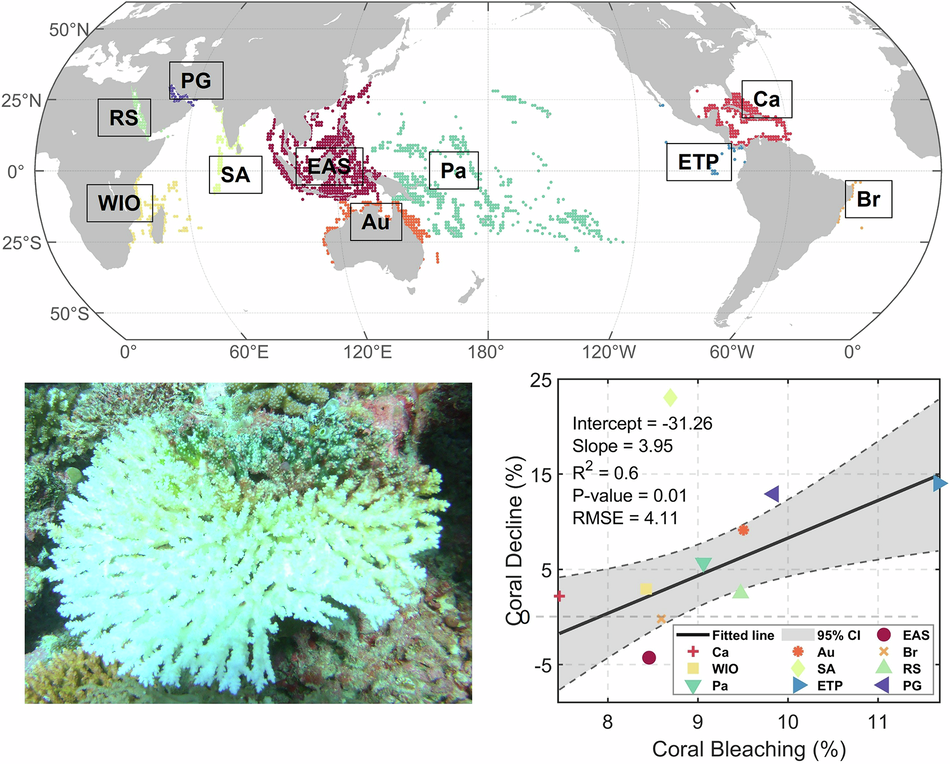Inevitable global coral reef decline under climate change-induced thermal stresses – Nature

Report on Global Coral Reef Degradation and its Implications for Sustainable Development Goals
Executive Summary
This report details the findings of a data-driven global analysis of coral reef bleaching, directly linking the impacts of climate change to the achievement of the Sustainable Development Goals (SDGs). A multivariate model, integrating historical observations and climate simulations, identified a critical annual bleaching threshold of 7.9%. Exceeding this threshold leads to significant, long-term degradation of coral reef ecosystems. Projections indicate that even under the most optimistic emission reduction scenarios, this threshold will be surpassed in all major tropical marine regions by 2100. This poses a direct threat to SDG 14 (Life Below Water) and underscores the urgent need for decisive global action on SDG 13 (Climate Action) to prevent catastrophic biodiversity loss and safeguard the livelihoods dependent on these vital ecosystems.
1.0 Introduction: Coral Reefs and the Sustainable Development Agenda
Coral reefs are critical marine ecosystems, supporting immense biodiversity and providing essential services to millions of people globally. Their health is intrinsically linked to several Sustainable Development Goals:
- SDG 14 (Life Below Water): Reefs are cornerstones of marine biodiversity and coastal protection, directly relevant to Target 14.2 to sustainably manage and protect marine and coastal ecosystems.
- SDG 1 (No Poverty) and SDG 2 (Zero Hunger): They support fisheries that provide food security and livelihoods for coastal communities.
- SDG 8 (Decent Work and Economic Growth): Reef-related tourism and industries are significant economic drivers in many nations.
However, the increasing frequency of mass coral bleaching events, driven by rising sea temperatures, presents a severe threat to these ecosystems. This phenomenon, a direct consequence of inadequate progress on SDG 13 (Climate Action), jeopardizes the viability of reefs and the achievement of the broader 2030 Agenda for Sustainable Development.
2.0 Analysis of Coral Bleaching Drivers and Thresholds
2.1 Model Development and Key Environmental Factors
A multivariate data-driven model was constructed using a random forest algorithm to project coral bleaching rates with high precision. The model integrated the Global Coral-Bleaching Database with 32 environmental indicators. Key findings on influencing factors include:
- Thermal Stress Variables: Temperature-related factors, particularly the variance of sea surface temperature anomalies (SSTA_SD) and the accumulation of thermal stress (TSA_DHW), were identified as the most critical predictors of coral bleaching extent. This confirms that climate change is the primary driver of reef degradation.
- Geographic and Depth Variables: Location and water depth also demonstrated significant influence, indicating that vulnerability and resilience vary regionally. This information is crucial for prioritizing conservation efforts in line with SDG 14.
2.2 Identification of a Critical Degradation Threshold
The analysis established a direct positive correlation between the average annual bleaching rate and the rate of coral cover decline. A critical threshold was identified:
- When the annual bleaching rate exceeds 7.9%, coral reef ecosystems enter a state of significant net degradation.
This threshold serves as a critical benchmark for assessing the sustainability of coral reefs. Surpassing this level indicates a failure to protect marine ecosystems as mandated by SDG 14 and signals an urgent need for enhanced climate mitigation under SDG 13.
3.0 Future Projections Under Climate Scenarios
Projections were developed for the periods 2020–2060 and 2060–2100 under three Shared Socioeconomic Pathway (SSP) emission scenarios, which directly correspond to different levels of global commitment to SDG 13 (Climate Action).
3.1 Low Emission Scenario (SSP1-2.6)
This scenario, aligned with the Paris Agreement goals, represents the most optimistic pathway for climate action.
- 2020-2060: Bleaching rates are projected to be between 8-12% across most regions, already exceeding the 7.9% degradation threshold.
- 2060-2100: Bleaching rates continue to rise, indicating that even successful implementation of current climate targets is insufficient to prevent widespread, long-term reef degradation. This highlights a critical gap in the global strategy for SDG 14.
3.2 Medium Emission Scenario (SSP2-4.5)
Reflecting moderate emission reductions, this scenario shows a more severe impact.
- The equatorial Pacific and Australian regions are projected to experience bleaching rates exceeding 15%.
- The majority of global reefs will face conditions far beyond their capacity for recovery.
3.3 High Emission Scenario (SSP5-8.5)
This scenario, representing a failure to curb emissions, projects a catastrophic future for coral reefs.
- 2060-2100: Widespread and severe bleaching (>15%) is projected across almost all coral reef regions.
- Potential refugia for corals shrink dramatically, limited to small, high-latitude areas. This outcome would represent a complete failure to achieve the targets of SDG 14.
4.0 Conclusion and Policy Recommendations for the SDGs
The findings present a grim outlook for the world’s coral reefs, indicating that their widespread decline is inevitable without immediate and transformative action. The window of opportunity to preserve these ecosystems is rapidly closing.
4.1 Prioritizing Global Climate Action (SDG 13)
The primary driver of coral bleaching is thermal stress from global warming. Therefore, the most critical action is aggressive global greenhouse gas emission reduction. The projections demonstrate that failing to meet and exceed the targets of SDG 13 will render efforts to achieve SDG 14 ineffective.
4.2 Integrating Local Conservation with Global Policy (SDG 14 & SDG 17)
While global mitigation is paramount, localized conservation measures are essential to build resilience. A dual approach is necessary:
- Strengthen Marine Protected Areas (MPAs): In line with Target 14.5, MPAs in identified climate refugia can buffer reefs from local stressors like pollution and overfishing, buying critical time for adaptation.
- Enhance Coral Resilience: Global partnerships (SDG 17) should be leveraged to invest in research and implementation of strategies that enhance the thermal tolerance of corals, such as assisted evolution and selective breeding.
Failure to act on both global and local fronts will result in profound consequences for marine biodiversity, ecosystem services, and the human livelihoods that depend on coral reefs, leading to significant setbacks in achieving the Sustainable Development Goals.
Analysis of Sustainable Development Goals (SDGs) in the Article
1. Which SDGs are addressed or connected to the issues highlighted in the article?
The article on the degradation of coral reefs due to global warming directly addresses and connects to the following Sustainable Development Goals (SDGs):
- SDG 14: Life Below Water: This is the most central SDG to the article. The entire study focuses on the health and sustainability of coral reefs, which are critical marine ecosystems. The article discusses the threats they face from coral bleaching, their degradation, and the urgent need for conservation, all of which are core components of SDG 14’s mission to “conserve and sustainably use the oceans, seas and marine resources for sustainable development.”
- SDG 13: Climate Action: The article explicitly identifies “global warming” and “climate change” as the primary drivers of the increased frequency and intensity of coral bleaching events. It analyzes different climate emission scenarios (SSPs) and calls for “bold and effective global policies” and “global emission reductions” to mitigate these impacts. This directly aligns with SDG 13’s call to “take urgent action to combat climate change and its impacts.”
2. What specific targets under those SDGs can be identified based on the article’s content?
Based on the article’s discussion of coral reef degradation, climate change impacts, and conservation needs, several specific SDG targets can be identified:
- Under SDG 14 (Life Below Water):
- Target 14.2: “By 2020, sustainably manage and protect marine and coastal ecosystems to avoid significant adverse impacts, including by strengthening their resilience, and take action for their restoration in order to achieve healthy and productive oceans.” The article directly addresses this by analyzing the degradation of coral reef ecosystems, discussing their resilience, and highlighting the need for conservation strategies like Marine Protected Areas (MPAs) to protect them from further decline.
- Target 14.a: “Increase scientific knowledge, develop research capacity and transfer marine technology… in order to improve ocean health and to enhance the contribution of marine biodiversity to the development of developing countries.” The study itself is a prime example of this target in action. It uses a “data-driven multivariate model,” “historical field observations,” and “climate simulations” to deepen the scientific understanding of coral bleaching, which is essential for informing effective conservation policies.
- Under SDG 13 (Climate Action):
- Target 13.1: “Strengthen resilience and adaptive capacity to climate-related hazards and natural disasters in all countries.” The article explores the concept of coral resilience and adaptation, noting that “Coral adaptation or domestication to increased thermal stress may help mitigate widespread coral degradation.” It assesses the capacity of these ecosystems to withstand the climate-related hazard of marine heatwaves.
- Target 13.2: “Integrate climate change measures into national policies, strategies and planning.” The article’s conclusion strongly advocates for this, stating that “global emission reductions must be urgently complemented by strategies to enhance coral resilience” and calling for the integration of “scientific innovation, policy interventions, and community-driven efforts.”
3. Are there any indicators mentioned or implied in the article that can be used to measure progress towards the identified targets?
Yes, the article mentions and implies several specific, measurable indicators that can be used to track progress towards the identified targets:
- Indicators for SDG 14 Targets:
- Coral Bleaching Rate: The article identifies a “critical bleaching threshold of 7.9% annually” beyond which significant degradation occurs. The “mean annual bleaching extent” is used as a key metric throughout the study to assess reef health, directly measuring the impact on the ecosystem (relevant to Target 14.2).
- Coral Cover and Decline Rate: The study uses “coral cover data from the sixth GCRMN Status of Coral Reefs of the World: 2020 Report” and analyzes the “average decline rate of coral reefs.” These are direct indicators of the health and status of marine ecosystems (relevant to Target 14.2).
- Indicators for SDG 13 Targets:
- Greenhouse Gas Emission Scenarios (SSPs): The article’s projections are based on three scenarios: high emission (SSP5-8.5), medium emission (SSP2-4.5), and low emission (SSP1-2.6). These scenarios are proxies for global greenhouse gas emissions and serve as indicators of the level of global climate action being taken (relevant to Target 13.2).
- Sea Surface Temperature (SST) Metrics: The study relies on metrics like “sea surface temperature anomalies (SSTA),” “thermal stress anomaly (TSA),” and “degree-heating week (DHW).” These are direct, quantifiable indicators of the physical impacts of climate change on the marine environment, which cause the climate-related hazards mentioned in Target 13.1.
4. Table of Identified SDGs, Targets, and Indicators
| SDGs | Targets | Indicators |
|---|---|---|
| SDG 13: Climate Action | Target 13.1: Strengthen resilience and adaptive capacity to climate-related hazards.
Target 13.2: Integrate climate change measures into policies and planning. |
– Sea surface temperature anomalies (SSTA) – Thermal stress anomaly (TSA) – Degree-heating week (DHW) – Shared Socioeconomic Pathway (SSP) emission scenarios (as a proxy for global emissions) |
| SDG 14: Life Below Water | Target 14.2: Sustainably manage and protect marine and coastal ecosystems to avoid significant adverse impacts.
Target 14.a: Increase scientific knowledge and research capacity to improve ocean health. |
– Annual coral bleaching rate (with a critical threshold of 7.9%) – Percentage of live coral cover – Rate of coral decline – Development of predictive, data-driven models for ecosystem assessment |
Source: nature.com
What is Your Reaction?
 Like
0
Like
0
 Dislike
0
Dislike
0
 Love
0
Love
0
 Funny
0
Funny
0
 Angry
0
Angry
0
 Sad
0
Sad
0
 Wow
0
Wow
0















































/environment-climate-change-and-health-(ech)/water-sanitation-hygiene-and-health-(wsh)/landfill-tuvalu-36092.tmb-1200v.jpg?sfvrsn=5c21fe40_1#)


.jpg.webp?itok=0ZsAnae9#)


























